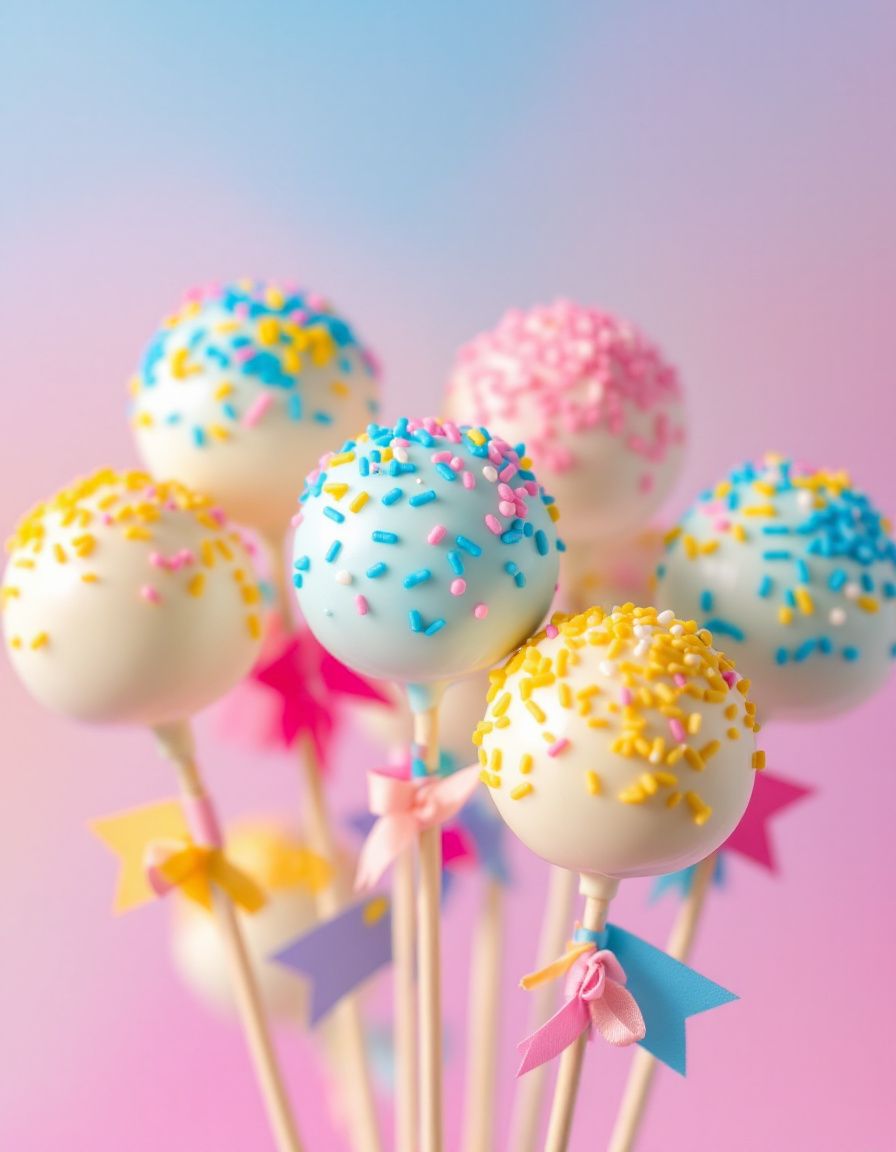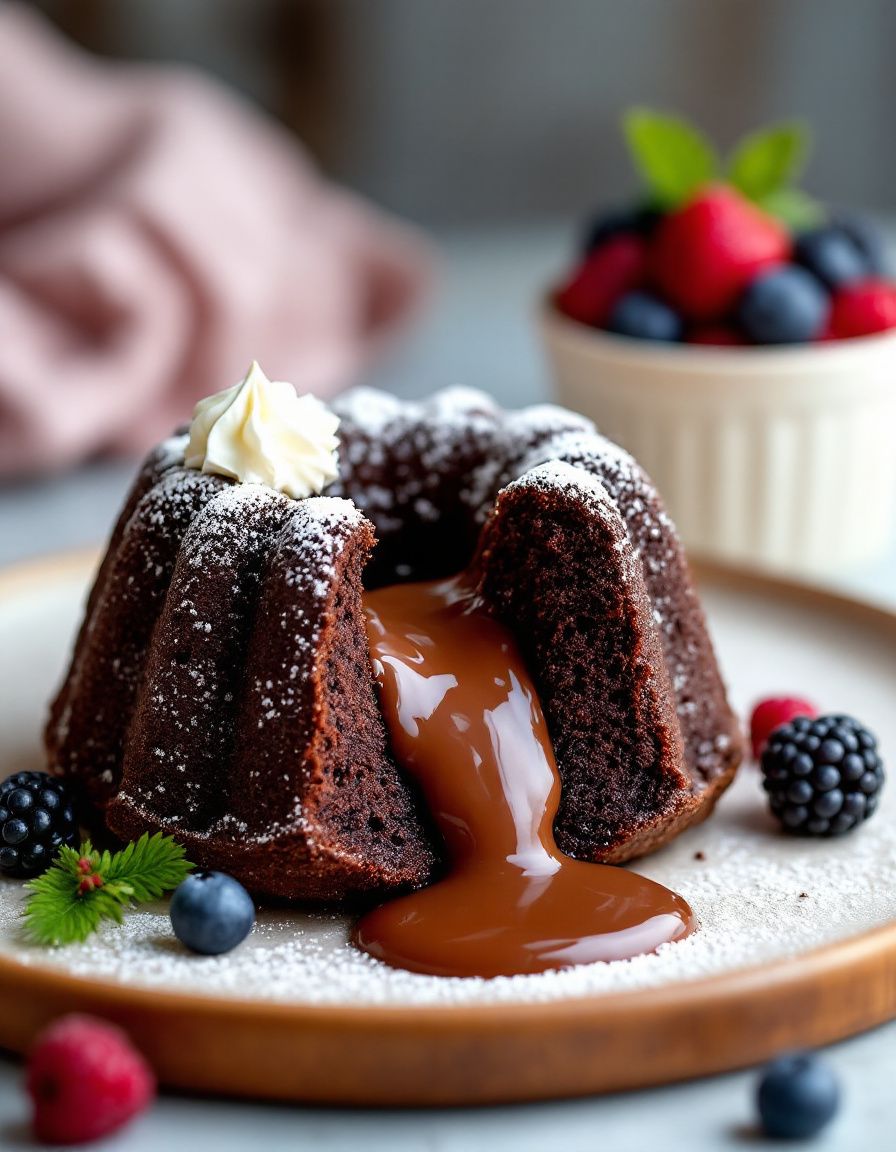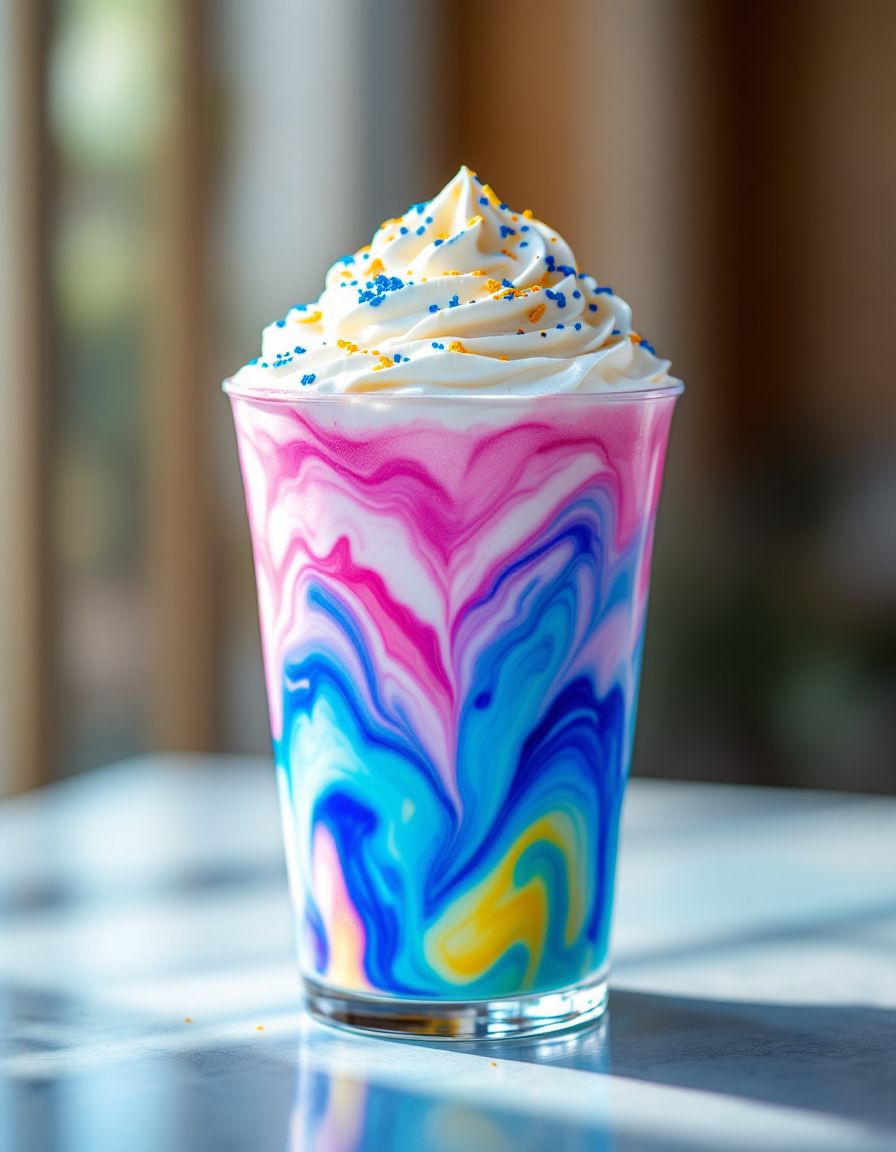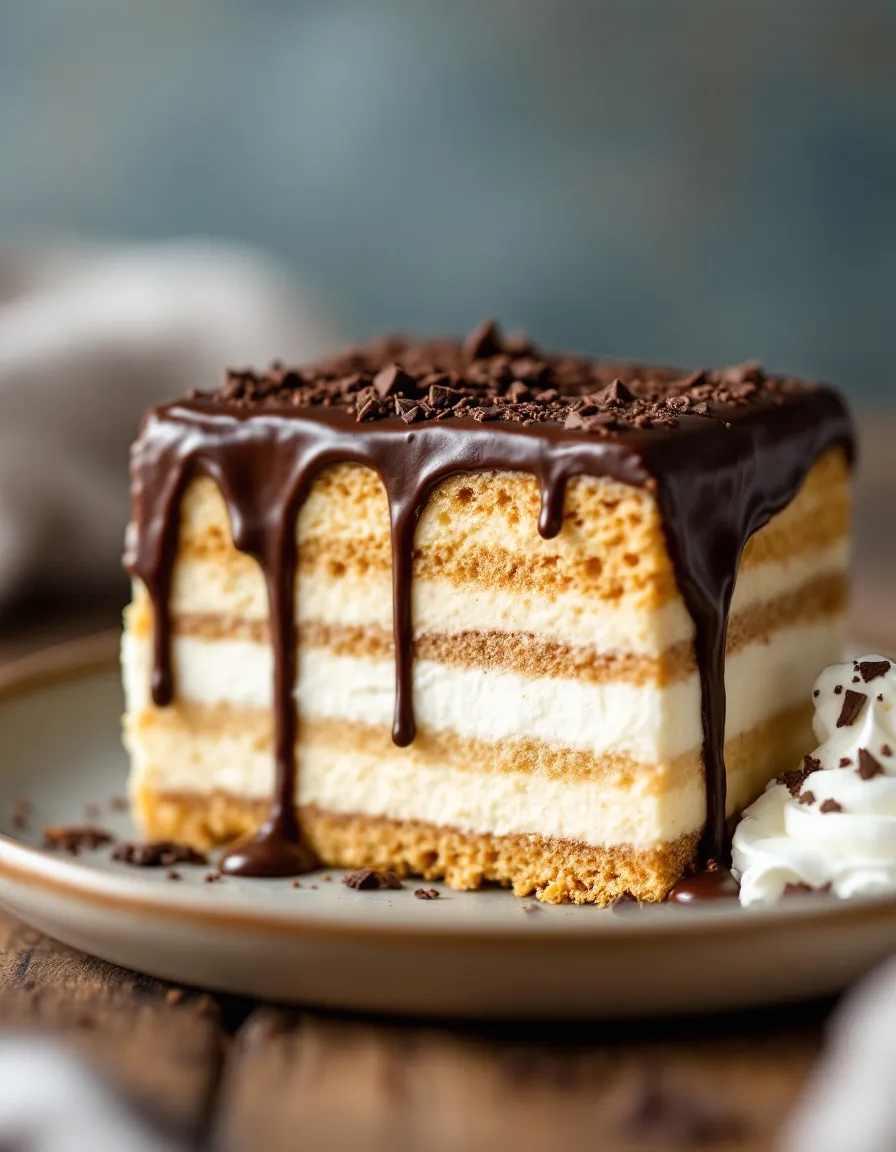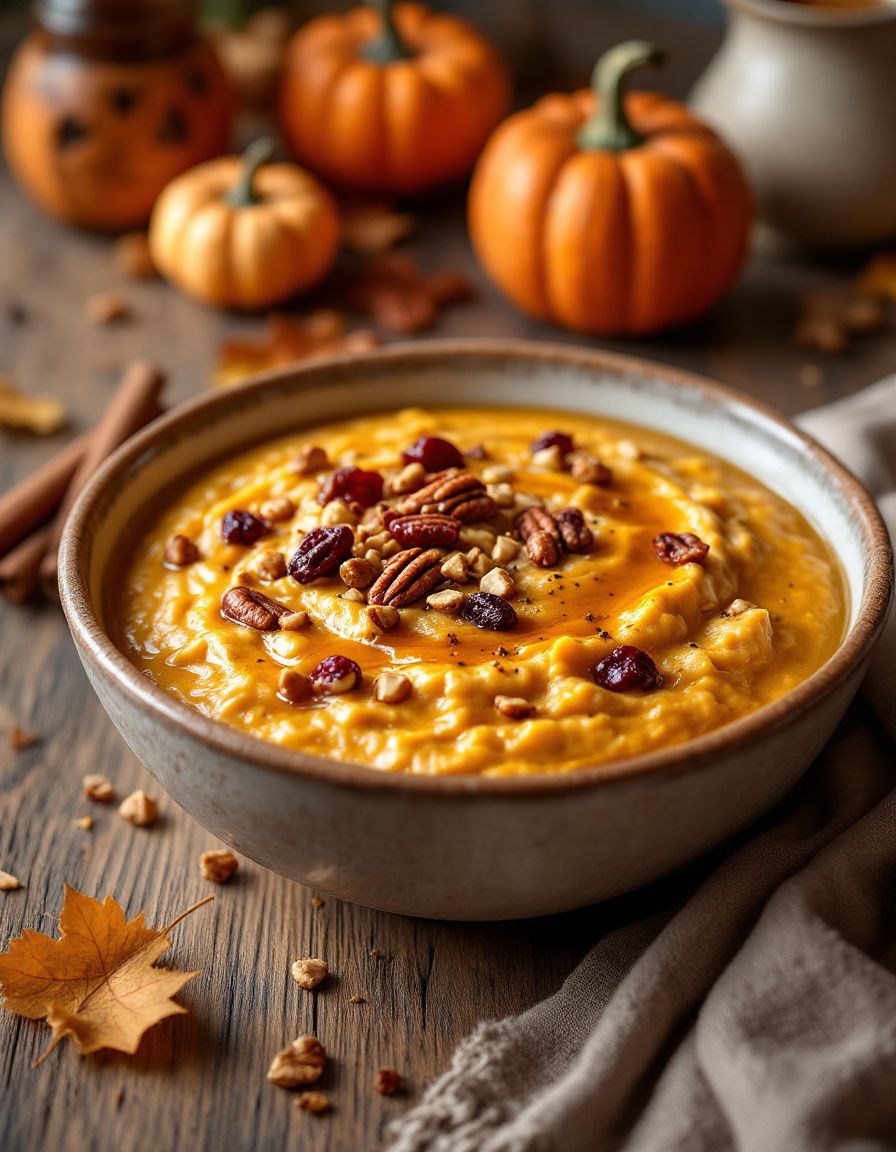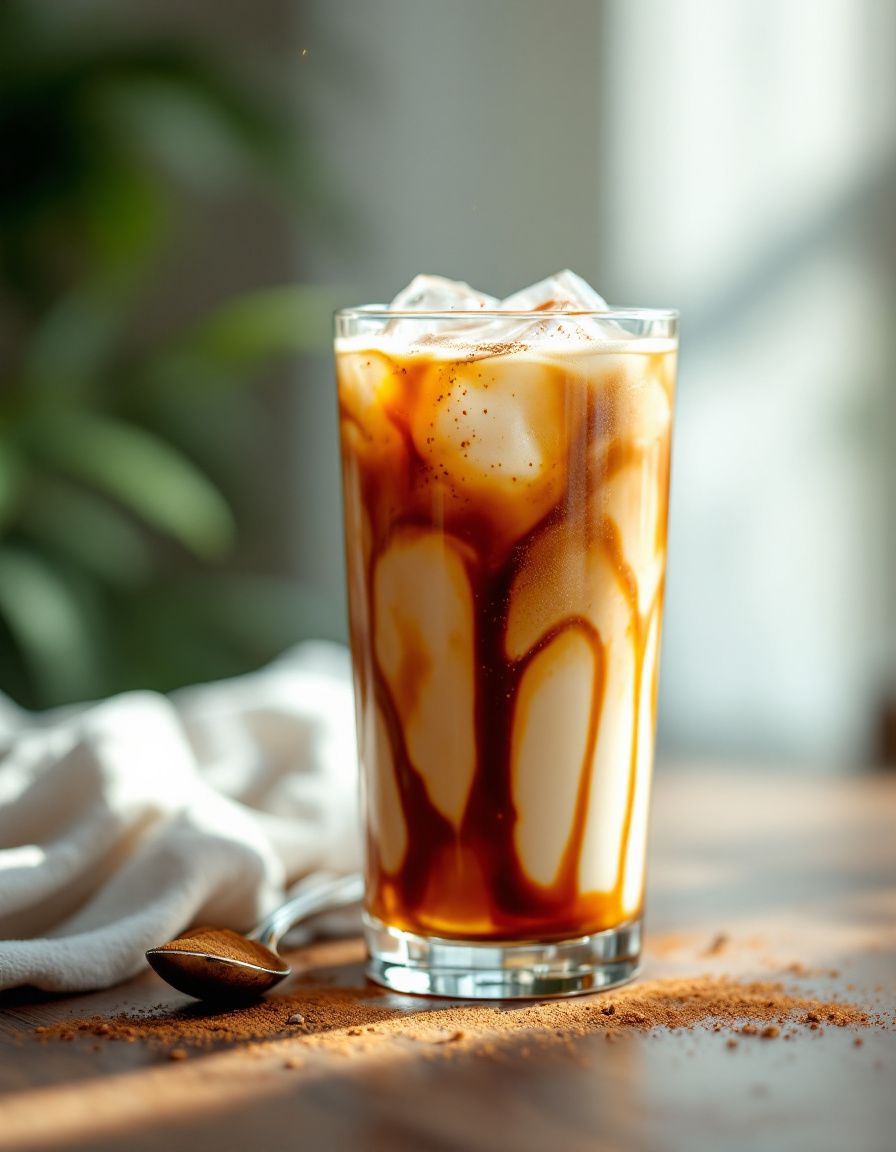The EASIEST Chai Tea Latte: A Simple Delight with Only 5 Ingredients!
The EASIEST Chai Tea Latte is your go-to recipe for a comforting and delicious drink that combines the warmth of traditional spices with the creaminess of milk. With just five simple ingredients, this chai latte comes together in minutes and offers a satisfying experience that will soothe your senses. The perfect balance of spicy and sweet, this easy chai recipe is perfect for chilly mornings or cozy evenings. You’ll savor the inviting aroma of cardamom and cinnamon as you brew this delightful beverage in your own kitchen.
Whether you’re taking a moment for yourself or sharing with friends, this chai tea latte provides a fulfilling taste of warmth and comfort. The simplicity of the recipe makes it accessible to everyone, from novice cooks to experienced bakers. Just imagine wrapping your hands around a warm mug filled with this creamy chai tea latte — it’s instant bliss!
Quick Recipe Highlights
- Flavor Profile: This chai latte thrives on the harmonious blend of bold black tea and aromatic spices, delivering a delightful mix of warmth and sweetness that gently awakens your palate.
- Texture: Experience the creamy smoothness of steamed milk that perfectly balances the spices, resulting in a velvety mouthfeel that feels indulgent and satisfying.
- Aroma: The scent of freshly brewed chai, infused with cardamom, cinnamon, and ginger, fills the air, creating a welcoming atmosphere perfect for relaxation.
- Visual Appeal: The chai tea latte boasts a lovely tan color, enriched by a frothy top that invites you to take a sip, often complemented by a sprinkle of cinnamon or nutmeg.
- Skill Level Needed: This easy recipe is perfect for beginners and requires minimal cooking skills, making it an exciting project for anyone looking to explore homemade beverages.
- Special Equipment: A simple saucepan and a whisk or milk frother are all you need to create this enchanting chai latte at home.
Recipe Overview
- Difficulty Level: This recipe is classified as easy, incorporating straightforward steps that anyone can follow without prior experience in the kitchen.
- Category: This chai latte falls into the beverage category, making it ideal for breakfast, an afternoon pick-me-up, or a cozy evening treat.
- Cuisine: Drawing from Indian culinary traditions, this beverage is inspired by the ancestral chai recipes that have delighted tea drinkers for generations.
- Cost: Making a homemade chai tea latte is budget-friendly, with ingredients that won’t break the bank and can be found in most kitchens.
- Season: This chai latte is perfect for fall and winter seasons but can brighten your day all year round, regardless of the weather.
- Occasion: Whether it’s a quiet morning at home, a gathering with friends, or a comforting evening snack, this recipe fits seamlessly into any occasion.
Why You’ll Love This Recipe
Firstly, the taste and texture of this chai tea latte are divine. The rich, creamy milk melds beautifully with the spicy chai, creating a balanced flavor that is both refreshing and comforting. With every sip, you’ll appreciate the depth of the spices and the smooth finish, leaving you wanting more. Pair this with a biscuit or a piece of cake to elevate your coffee break.
Convenience and ease of preparation are another reason you’ll adore this recipe. In less than 10 minutes, you can have a luxurious beverage that feels like a special treat. Perfect for those mornings when you need a little extra motivation to start your day, this latte can be prepared in no time. Plus, you can easily adjust the level of sweetness and spiciness to cater to your preferences.
From a nutritional standpoint, the chai tea latte is an excellent choice. The presence of spices such as ginger and cardamom not only adds flavor but also brings health benefits such as aiding digestion and boosting immunity. When made with unsweetened almond or oat milk, this drink can also fit various dietary needs, making it a versatile choice for many diets.
In addition, this chai tea latte is perfect for social settings. Imagine inviting friends over and serving them this warm, spiced beverage — it instantly sets a cozy atmosphere. You can even create a mini tea party by preparing different flavors or toppings, making it a more interactive experience that friends will love.
Lastly, considering cost-effectiveness, brewing your chai tea latte at home is much cheaper than purchasing one from a café. Ingredients are likely already at hand, and with just a few pantry staples, you can create café-quality lattes. Plus, there’s something incredibly rewarding about crafting your beverages at home.
Historical Background and Cultural Significance
The origin of chai tea dates back centuries in India, where it was traditionally served in homes as a soothing beverage. Initially, the spiced tea was considered medicinal, made from various herbs and spices thought to aid digestion and combat illnesses. As tea gained popularity in British colonial times, chai evolved into a more accessible drink, leading to the flavors and jarring popularity we know today.
Culturally, chai represents hospitality in India. Offering a cup of chai to guests is a common and cherished custom, symbolic of welcoming someone into your home. This beverage has woven itself into the social fabric of Indian life, fostering connection and conversation over generations.
Over time, the chai tea recipe has evolved with circulating influences and parent recipes, adapting to various tastes and preferences. Variations with different spices, milk types, and sweeteners emerged, contributing to the rich tapestry of flavors associated with chai tea globally. Each region has its twist, reflecting the local culture and preferences.
Today, regional variations abound, with chai becoming a beloved drink worldwide. Whether it’s a sweetened version with cinnamon or a spiced latte with black pepper, world travelers and tea enthusiasts continue to reinvent this iconic beverage while honoring its roots.
Ingredient Deep Dive
Tea: Black tea is the foundation of the chai tea latte, providing robust flavor and a caffeine boost. Traditionally, Assam tea or Darjeeling tea is used due to their strong profiles. The health benefits of black tea include antioxidants that promote heart health and improve metabolism. When selecting tea, choose high-quality loose leaf or teabags for the best flavor. Store tea in a cool, dark place away from moisture to maintain freshness.
Spices: The warm spices in chai, typically cardamom, cinnamon, and ginger, form the aromatic profile. Ginger aids digestion, while cardamom has anti-inflammatory properties. When selecting spices, opt for whole spices for the freshest flavor and grind them before use if possible. The storage of spices should also be in airtight containers, away from direct sunlight to retain their potency.
Milk: Milk adds creaminess to the chai tea latte. Dairy, or plant-based alternatives like almond or oat milk, are excellent options. Plant-based milks often have added health benefits such as lower calories and a lactose-free option. When choosing milk, look for unsweetened varieties to control sweetness levels and stay fresh in the fridge, using within a week of opening.
Sweetener: The sugar or honey you choose to sweeten your chai latte can greatly influence the flavor. While typical choices include sugar or honey, alternatives like maple syrup or agave can also work well. Choosing natural sweeteners can provide additional health benefits. Store in a cool, dry place and keep an eye on expiry dates for optimal quality.
Water: The most overlooked ingredient, high-quality water can significantly alter the taste of tea. Using filtered water can enhance the flavors and ensure a clean, crisp drink. Store water in a clean jug or pitcher, keeping it refrigerated for the best taste.
Common Mistakes to Avoid
- Overcooking the spices: Allowing the spices to simmer for too long may result in a bitter taste. Just simmer them together for a few minutes to keep the flavor balanced.
- Forgetting to strain the tea: Leaving the tea leaves in the mixture can lead to an overly strong and tannic flavor. Strain the tea before adding milk for a smoother taste.
- Using low-quality tea: Cheap tea can result in a lackluster flavor. Opt for high-quality loose leaf or bags for the best results.
- Not adjusting sweetness: Everyone has different sweetness preferences. Taste as you go and adjust the sweetener to your liking.
- Using cold milk: Adding cold milk to hot tea can lead to a temperature drop. Use warmed milk or froth it before combining.
- Ignoring measurements: Skip the guesswork and be precise with your measurements to ensure consistent results every time.
- Skipping the frothing: Frothing the milk adds a delightful texture to your chai latte. Don’t miss this step for the best experience.
- Removing the spices too soon: For the fullest flavor, give the spices adequate time to steep in the boiling water before adding the tea.
- Not experimenting: Feel free to play with different spices or dairy alternatives. Each adjustment can lead to surprising, delightful results.
- Forgetting to garnish: A sprinkle of cinnamon or nutmeg on top can take your chai latte to another level of elegance — it’s all in the details!
Essential Techniques
Cooking the spices carefully is essential to releasing their full flavor potential. Start by lightly toasting whole spices in the pan to awaken their natural oils before adding water. Mastering this technique ensures you get the aromatic depth typical of a well-made chai latte. Avoid high heat, as it can lead to burning rather than toasting.
Straining the tea is another key technique. Use a fine mesh sieve to separate the brewed leaves and spices from the liquid for a clean finish. This step prevents undesirable bits from floating in your drink, enhancing the visual appeal and texture of your latte.
Pro Tips for Perfect The EASIEST Chai Tea Latte
Start with fresh spices: Fresh spices have more potent flavors, so always opt for whole spices when you can.
Experiment with milk: Try different milk varieties, such as oat, almond, or coconut, to discover your favorite flavor combinations.
Sweeten to taste: Add sweeteners gradually to achieve the perfect balance for your palate without overpowering the chai’s natural flavors.
Chill the tea: For a delicious iced version, let your chai tea cool, then pour it over ice and top with cold milk.
Pre-brew the tea: Brew a larger batch of chai concentrate ahead of time to enjoy quick chai lattes whenever you want.
Garnish creatively: Get artistic with garnishes — consider a sprinkle of cocoa powder, a slice of fresh ginger, or a sprig of mint.
Try alternative spices: Don’t hesitate to experiment with spices like cloves or turmeric for a unique twist on the classic recipe.
Make it a chai tea frappé: Blend your prepared chai latte with ice for a refreshing summertime treat.
Variations and Adaptations
Regional variations can dramatically change your chai tea latte. For instance, in certain regions, cloves and black pepper are popular additions, lending a different spice profile. Adapt the core recipe to include local spices you enjoy for an exciting twist on the traditional flavors.
Seasonal adaptations offer an opportunity to get creative. In the fall, consider adding pumpkin spice to your chai latte to celebrate the season, or in the summer, switch to an iced version for a cooling treat.
Dietary modifications can easily be made to this recipe. For a vegan option, substitute dairy milk with almond or soy milk, and raise the natural sweetness with maple syrup instead of honey for a flexible beverage option suitable for all diets.
Flavor variations can alter the experience immensely. Adding flavored syrups, such as vanilla or caramel, can give it a unique aromatic touch and a hint of sweetness.
Texture modifications can simply be achieved by adjusting the milk-to-water ratio. More milk results in a creamier latte, while less can lead to a more traditional, tea-focused drink.
Presentation alternatives can elevate your chai experience at gatherings. Serve in unique mugs or glasses, and consider layering frothy milk art on top for an Instagram-worthy finish.
Serving and Presentation Guide
Plating techniques matter for an aromatic beverage like chai. Serve your chai latte in clear glass mugs to showcase the beautiful color and frothy top. Consider a stylish saucer to complement the drink and add a hint of elegance.
Garnishing ideas can take your drink up a notch. A light dusting of cinnamon or nutmeg on top adds a visually appealing finish while enhancing the warm aroma.
Traditional accompaniments like biscuits or chai-spiced cookies are perfect pairings that can elevate the overall experience of enjoying your chai treat.
Modern serving suggestions may include iced versions or even chai lattes adorned with whipped cream for a café-style indulgence.
Temperature considerations are crucial; serve immediately while hot to enjoy the full experience. If preparing ahead, reheat gently, avoiding boiling to preserve the flavors.
Portion control tips are essential for large gatherings. Make a pitcher of chai latte, allowing guests to serve themselves at their leisure while keeping the flavor and heat intact.
Wine and Beverage Pairing
Wine pairings for chai tea latte can be unusual but delightful. A smooth dessert wine with notes of spice can complement the latte’s flavors beautifully without overpowering it.
Non-alcoholic alternatives like fresh fruit juices or flavored sparkling water pair harmoniously, providing a refreshing counterpoint to the chai’s warmth while cleansing the palate.
For coffee/tea pairings, serving chai alongside a milder coffee can create a pleasing combo of rich flavors, inviting coffee lovers to embrace a new tea experience.
Temperature considerations for pairing drinks are important. Consider serving chilled beverages alongside warmer chai lattes to enhance their distinct characters.
Serving suggestions for a well-rounded experience could include a small platter of assorted treats meant to complement the chai’s spices, ensuring a delightful gathering.
Storage and Shelf Life
Storage methods for leftover chai are simple. Keep any uneaten chai latte in an airtight container in the refrigerator for up to three days. Reheat gently for best flavor retention.
Temperature requirements are vital; only refrigerate the latte after it has cooled to preserve its integrity. Avoid leaving it out for extended periods after preparation.
Container recommendations lean toward glass, as it doesn’t hold odors from previous contents and keeps beverages fresh longer.
Signs of spoilage can manifest as an unusual odor or separation. If unsure, trust your senses — discard if something seems off.
Reheating instructions are straightforward: heat in a saucepan over low heat, stirring to avoid burning while restoring its original texture.
Freezing guidelines can also be applicable; if you make a large batch, freeze portions in ice cube trays, then transfer to freezer bags for future use in smoothies or iced drinks!
Make Ahead Strategies
Prep timeline for this recipe allows for flexibility. Brew a batch of chai and store it in the fridge. Simply heat and froth milk when you’re ready to indulge in your favorite latte.
Storage between steps means keeping all components separate until ready to serve. This maintains freshness and flavor integrity without compromising the final result.
Quality impact assessment is crucial — remember that while you can make it ahead, the freshness on serving day remains unparalleled. Prep as close to serving time as possible for the best experience.
Assembly tips encourage pre-brewing. Have chai concentrate cooled and ready so you can quickly blend it with milk and sweetener when guests arrive.
Reheating guidelines stress patience. Heat slowly to prevent boiling, which can change the taste and texture. Stir while reheating for an even warmth.
Fresh element additions could include a dash of cinnamon or whipped cream just before serving, enhancing your chai latte with a touch of novelty.
Scaling Instructions
Halving the recipe is simple — use half the amount of each ingredient while keeping the same method. Test for taste after preparation to ensure balance.
Doubling or tripling the recipe works well for gatherings. Just ensure all ingredients scale properly without losing the intended flavors, which are key to this classic beverage.
Equipment adjustments may be necessary for larger batches. Ensure you have a larger pot and a suitable whisk or frother to handle increased volumes effectively.
Timing modifications will depend on your batch size; expect slightly longer cooking times for larger quantities to allow for even flavor extraction from spices.
Storage considerations should include separate containers for different batches if preparing ahead, ensuring a fresh taste and minimizing spoilage risk.
Nutritional Deep Dive
The macro breakdown for a chai latte typically provides protein from the milk, carbohydrates from sweeteners, and fats, depending on the milk choice used. Maintaining a balanced ratio can benefit overall nutrition while satisfying cravings for a warm drink.
Micronutrient analysis reveals the presence of beneficial vitamins and minerals derived from spices. For instance, cinnamon is known for supporting heart health, while ginger is recognized for its anti-inflammatory properties.
Health benefits of chai include its robust antioxidant content, which can aid overall wellness. Consuming chai can be a delightful way to integrate ingredients that boost energy and enhance mood.
Dietary considerations should take personal diets into account. For those monitoring caloric intake or seeking to manage weight, using unsweetened milk and limiting additional sweeteners can create a lighter drink.
Portion analysis reveals that moderation is key! Enjoying a single serving alongside a healthy snack can satisfy cravings without overindulging.
Weight management tips may include swapping whole milk for low-fat alternatives or reducing sugar to maintain a delightful flavor without excess calories.
Dietary Adaptations
For gluten-free adjustments, this chai tea latte is naturally gluten-free — just ensure that any ingredients used are certified gluten-free to avoid cross-contamination.
Dairy-free modifications can be achieved using plant-based milk alternatives, such as almond or coconut milk, allowing for a delicious vegan option that is still creamy and satisfying.
Vegan versions vary based on sweeteners; replacing honey with maple syrup or agave ensures that the recipe remains plant-based without losing flavor.
Low-carb adaptations can involve using stevia or erythritol in place of sugar to lower carb content while maintaining sweetness for balance.
Keto modifications focus on using unsweetened coconut milk and avoiding added sugars, making it a great beverage for those following a ketogenic diet.
Paleo options incorporate natural sweeteners while avoiding refined sugar, focusing on a clean ingredient list to align with paleo dining principles.
For a low-FODMAP chai latte, use lactose-free milk and limit certain spices to ensure compatibility with this dietary approach.
Other specific diets can explore the use of alternative milks like hemp or flaxseed milk to suit various nutritional needs without sacrificing flavor.
Troubleshooting Guide
Texture issues often arise when milk curdles. Avoid this by warming milk gradually instead of boiling, which can cause separation. Always reheat gently and stir.
Flavor balance can be tricky. If your chai latte tastes too bitter, consider reducing steep time or adjusting spice quantities in future batches to control strength.
Temperature problems may come from serving too cold. Ensure the milk is warmed adequately during preparation, and consider warming cups before serving to maintain heat.
Equipment challenges might appear when you don’t have a frother. Use a mason jar to shake and create froth or whisk vigorously in a bowl for a similar effect.
Ingredient substitutions might seem daunting. Keep in mind that dried spices may have different intensities than fresh; adjust accordingly when substituting or blending flavors.
Timing concerns are common, especially if guests are waiting. Prepare chai concentrate in advance but hold off on adding milk until serving to ensure freshness.
Recipe Success Stories
Community feedback highlights the ease with which individuals tackle this chai latte, often sharing their personal variations that reflect unique tastes. Many have delighted in customizing the spice level or trying new milk alternatives.
Variation successes show that playfulness with ingredients can lead to outstanding results. Readers have reported back with their spins, suggesting alternative spices such as nutmeg or even flavored syrups that elevate their experiences.
Adaptation stories illustrate the versatility of this recipe; it’s been transformed into iced lattes, chai smoothies, or even muffins, showcasing its flexibility across different contexts.
Reader suggestions emphasize the value of personal feedback in recipe creation, fostering a community dialog around what makes this drink truly special — gathering around good food!
Photography tips from users demonstrate the beauty of this drink, encouraging others to capture their creations and share them through social media, further enhancing engagement.
Frequently Asked Questions
How can I customize my chai tea latte?
You can customize your chai tea latte by adjusting the amount and type of spices, experimenting with different milk options, or adding flavored syrups or sweeteners to suit your taste.
What type of tea is best for chai lattes?
Typically, strong black teas such as Assam or Darjeeling are preferred for making chai lattes, providing depth of flavor that complements the spices well.
Can I make a chai tea latte without spices?
While spices are essential for a classic chai latte, you can create a simplified version using just black tea and milk, adjusting sweetness as desired.
Is it possible to make a caffeine-free chai tea latte?
Yes, you can make a caffeine-free version by using herbal teas like rooibos and incorporating the same spices to retain the chai’s flavor profile.
What milk alternatives can I use?
Almond, oat, soy, or coconut milk all work wonderfully in chai lattes. Choose unsweetened versions for better control over sweetness.
How long does a chai tea latte stay fresh?
A homemade chai tea latte should be consumed within three days if refrigerated; however, the freshest experience occurs when enjoyed immediately.
Can I freeze chai tea lattes?
Yes! You can freeze brewed chai tea in ice cube trays and blend them into smoothies or iced lattes later for a refreshing treat.
How do I froth milk without a frother?
To froth milk without a frother, pour warmed milk into a mason jar, secure the lid, and shake vigorously. Alternatively, whisk the milk vigorously in a bowl.
What spices are essential for a traditional chai latte?
Essential spices for traditional chai include cardamom, cinnamon, ginger, and sometimes cloves or black pepper, all contributing to its warm flavor profile.
How can I make my chai tea latte more indulgent?
Add a dollop of whipped cream on top, a drizzle of caramel or chocolate sauce, or serve it with a side of your favorite cookies for added indulgence!
Additional Resources
Related recipes, such as a spiced pumpkin latte or turmeric latte, can introduce additional flavors that enhance your chai experience. Discover these recipes to expand your beverage repertoire.
Technique guides detailing the various methods used for brewing tea and frothing milk can further enhance your results, ensuring you craft the perfect drink every time.
Ingredient information about different spices and their benefits provides insight into making intentional choices that elevate your chai tea latte to new heights.
Equipment recommendations highlight essential tools like high-quality whisks, tea infusers, and strainers that make preparing drinks easier and more enjoyable.
Seasonal variations encourage embracing ingredients from various times of the year; apple spice chai for fall or refreshing iced chai for summer will diversify your options, keeping your beverage enjoyable year-round.
Join the Conversation
Don’t forget to share your chai tea latte creations across social media platforms; use vibrant photography that showcases your drink and engage with others over their variations.
Encourage friends and family to partake in the chai experience, inspiring each other to explore different spices or milk options that enhance their personal recipes.
Recipe reviews play an important role in community building, so don’t hold back! Share your experiences and adjustments with others, showcasing your unique take on this delightful beverage.
Community engagement opportunities abound where you can connect with fellow chai lovers and share tips for perfecting this timeless recipe!
Recipe variations should be celebrated! Encourage readers to experiment boldly while emphasizing the joy of personalizing recipes, fostering a sense of creativity in the kitchen.
The Recipe
The EASIEST Chai Tea Latte
Serves: 2 cups
Prep Time: 5 mins
Cook Time: 5 mins
Total Time: 10 mins
Kitchen Equipment Needed
- Medium saucepan
- Whisk or milk frother
- Fine mesh strainer
- Mug or glass for serving
Ingredients
- 2 cups of water
- 2 black tea bags (or 2 teaspoons of loose leaf black tea)
- 1 teaspoon ground cinnamon
- 1 teaspoon ground ginger
- 1 cup of milk (dairy or plant-based)
- Sweetener to taste (sugar, honey, or alternatives)
Directions
- In a medium saucepan, bring water to a boil. Once boiling, add the black tea bags and spices. Simmer for 3-5 minutes, depending on your preferred strength.
- Remove from heat and strain the tea into a separate container, discarding the tea bags and spices.
- Return the strained tea to the saucepan. Add the milk and sweetener, stirring well to combine.
- Heat over low heat until warmed through, ensuring it does not boil. Whisk or froth the milk to create a creamy texture.
- Pour the chai tea latte into your favorite mug and garnish with an extra sprinkle of cinnamon if desired. Serve immediately and enjoy!
Recipe Notes
- Feel free to adjust the spice amounts to suit your taste.
- For a strong chai flavor, let the tea steep longer.
- Try experimenting with a variety of plant-based milk for a unique flavor profile.

